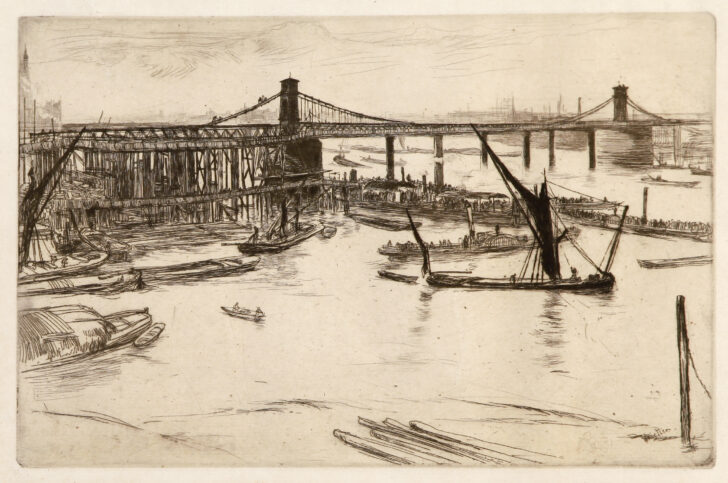Old Hungerford Bridge, from the ‘Sixteen Etchings,’ or the ‘Thames Set’
James Abbott McNeill Whistler

Description
Old Hungerford Bridge, from Sixteen Etchings, or the Thames Set
1861
Etching
Third state of three (Kennedy 76)
Bequest of Margaret Watson Parker, 1955/1.121
Many of London’s picturesque bridges were replaced during the 1860s and 1870s as part of an infrastructure upgrade and Whistler memorialized a number of them, including the graceful old Hungerford Bridge. The original pedestrian bridge, built in 1841 by I. K. Brunel (1806–1859), was being dismantled when Whistler etched it—in the etching men are seen removing the suspension cables that lead to the main pier on the near side. The new railroad bridge that replaced it in 1864 was the Charing Cross Bridge.
The crisp linearity of Whistler’s earlier Thames Set etchings here has given way to a much more delicate depiction characterized by wispy, feathery strokes. In contrast to the riverside views bustling with action, the artist takes a more distant view that encompasses a large stretch of the river, allowing the bridge to be shown in its entirety and offering an opportunity for a more atmospheric treatment of the scene.
Subject Matter:
This view of the old Hungerford Bridge dominates the scene which both in the foreground and in the distance under and behind the bridge can be seen the thriving shipping along the Thames so frequently the subject of Whistler's "Thames Set" etchings.
Physical Description:
The thriving commercial activity of a metropolitan river is shown as ships and barges of all types maneuver along the river's edge in the foreground. In the middle distance a bridge spans the water and beyond more buildings are loosely sketched in.
Usage Rights:
If you are interested in using an image for a publication, please visit https://umma.umich.edu/request-image/ for more information and to fill out the online Image Rights and Reproductions Request Form.